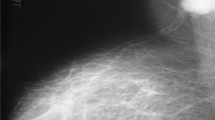Abstract
Ectopic breast tissue comes in two forms: supernumerary and aberrant. Despite morphologic differences, ectopic breast tissue presents characteristics analogous to orthotopic breast tissue in terms of function and, most importantly, pathologic degeneration. Data in the literature concerning its precise incidence, the probability of malignant degeneration, and its standardized management are scarce and controversial. This study selected more than 100 years of literature, and this report discusses a case of ectopic breast cancer treatment, suggesting novel therapeutic advice that could bring considerable clinical advantages, improve cosmetic results, and reduce the psychological impact on patients.
Level of Evidence V
This journal requires that authors assign a level of evidence to each article. For a full description of these Evidence-Based Medicine ratings, please refer to the Table of Contents or the online Instructions to Authors www.springer.com/00266.

Similar content being viewed by others
Notes
Polymastia may be unilateral (more frequently on the left side) or bilateral, located along the milk line above or below orthotopic breasts [22].
Polythelia generally presents itself as a unilateral lesion, most frequently located above the normal nipple (87 %) as opposed to below it (13 %) [22].
Because of complexities specific to lymphatic drainage, clinical treatment of patients with tumors such as breast cancers involves lymphatic mapping with either vital dyes and direct vision at surgery or radiopharmaceuticals for scintigraphic mapping with a gamma camera and intraoperative identification of sentinel lymph nodes using a specially built probe [27, 28].
References
Williams W (1891) Polymastism, with special reference to mammae erraticae and the development of neoplasms from supernumerary mammary structures. J Anat Physiol 25(pt 2):225–255
Nakao A, Saito S (1998) Ectopic breast cancer: a case report and review of the Japanese literature. Anticancer Res 18:3737–3740
Senatore G, Zanotti S (2010) Ectopic breast fibroadenoma: a case report. G Chir 31:96–99
Giron G, Friedman I (2004) Lobular carcinoma in ectopic axillary breast tissue. Am Surg 70:312–315
Kajawa Y (1915) The proportions of supernumerary nipples in the Finnish population. Duodecim 31:143–170
Chan N, Penswick J (2007) Ectopic breast tissue presenting as an anal polyp. Can J Surg 50:E23–E24
Cutler M (1962) Tumors of the breast. Pitman Medical, London
Marshall M, Moynihan J (1994) Ectopic breast cancer: a case report and literature review. Surg Oncol 3:295–304
Sappey M (1888) Anatomie, Physiologie, Pathologie des Vaisseaux Lymphatiques Consid′Eres chez L’homme et les Vertebres, 4th edn. Delahaye et Lecrosnier, Paris
Howell A, Cuzick J (2005) Results of the ATAC (Arimidex, tamoxifen, alone or in combination) trial after completion of 5 years’ adjuvant treatment for breast cancer. Lancet 365:60–62
Goldhirsch A, Glick J (2005) Meeting highlights: international expert consensus on the primary therapy of early breast cancer. Ann Oncol 16:1569–1583
Ghosn S, Khatri K (2007) Bilateral aberrant axillary breast tissue mimicking lipomas: report of a case and review of the literature. Cutan Pathol 34(Suppl 1):9–13
Cogswell H, Czerny E (1961) Carcinoma of aberrant breast of the axilla. Am Surg 27:388–390
Dzodic R, Stanojevic B (2010) Intraductal papilloma of ectopic breast tissue in axillary lymph node of a patient with a previous intraductal papilloma of ipsilateral breast: a case report and review of literature. Diagn Pathol 12:5–17
Kahraman-Cetintas S, Turan-Ozdemir S (2008) Carcinoma originating from aberrant breast tissue: a case report and review of the literature. Tumori 94:440–443
Nihon-Yanagi Y, Ueda T (2011) A case of ectopic breast cancer with a literature review. Surg Oncol 20:35–42
Teke Z, Kabay B (2008) Primary infiltrating ductal carcinoma arising in aberrant breast tissue of the axilla: a rare entity: report of a case. Tumori 94:577–583
Intra M, Maggioni A (2006) A rare association of synchronous intraductal carcinoma of the breast and invasive carcinoma of ectopic breast tissue of the vulva: case report and literature review. Int J Gynecol Cancer 16(Suppl 1):428–433
Loukas M, Clarke P (2007) Accessory breasts: a historical and current perspective. Am Surg 73:525–528
Gabriel A, Maxwell G (2009) Breast embryology. http://emedicine.medscape.com/article/1275146-overview
Caceres M, Shih J (2002) Metaplastic carcinoma in an ectopic breast. South Med J 95:462–466
Merlob P (2003) Congenital malformations and developmental changes of the breast: a neonatological view. J Pediatr Endocrinol Metab 16:471–485
Yuksel S, Coban YK (2011) Polymastia with diastometamyelia: case report. J Inonu Univ Med Faculty 18(1):47–49
Zannolli R, Mostardini R (2000) Char syndrome: an additional family with polythelia, a new finding. Am J Med Genet 95:201–203
Bartsich SA, Ofodile FA (2011) Accessory breast tissue in the axilla: classification and treatment. Plast Reconstr Surg 128:35e
Tjalma W, Senten L (2006) The management of ectopic breast cancer: case report. Eur J Gynaecol Oncol 27:414–416
Krag D, Weaver DL (1993) Surgical resection and radiolocalization of the sentinel lymph node in breast cancer using a gamma probe. Surg Oncol 2:335–339
Giuliano A, Kirgan D (1994) Lymphatic mapping and sentinel lymphadenectomy for breast cancer. Ann Surg 220:391–398
Cakan N, Kamat D (2007) Gynecomastia: evaluation and treatment recommendations for primary care providers. Clin Pediatr Phila 46:487–490
Benito-Ruiz J, Raigosa M, Manzano M, Salvador L (2009) Assessment of a suction-assisted cartilage shaver plus liposuction for the treatment of gynecomastia. Aesthet Surg J 29(4):302–309
Gutermuth J, Audring H (2006) Primary carcinoma of ectopic axillary breast tissue. J Eur Acad Dermatol Venereol 20:217–221
Francone E, Murelli F (2010) Orbital swelling as first symptom in breast carcinoma diagnosis: a case report. J Med Case Reports 4:211
Acknowledgment
The authors declare that they have no commercial interest. No organization sponsored the research. All the authors have full control of all primary data.
Author information
Authors and Affiliations
Corresponding author
Rights and permissions
About this article
Cite this article
Francone, E., Nathan, M.J., Murelli, F. et al. Ectopic Breast Cancer: Case Report and Review of the Literature. Aesth Plast Surg 37, 746–749 (2013). https://doi.org/10.1007/s00266-013-0125-1
Received:
Accepted:
Published:
Issue Date:
DOI: https://doi.org/10.1007/s00266-013-0125-1




